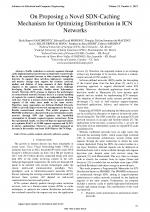| 1/2023 - 7 |
On Proposing a Novel SDN-Caching Mechanism for Optimizing Distribution in ICN NetworksNASCIMENTO, E. B. |
| View the paper record and citations in |
| Click to see author's profile in |
| Download PDF |
Author keywords
cache, content, network, software, system
References keywords
networking(24), software(12), information(12), defined(12), centric(12), networks(8), network(8), communications(8), architecture(6), management(5)
Blue keywords are present in both the references section and the paper title.
About this article
Date of Publication: 2023-02-28
Volume 23, Issue 1, Year 2023, On page(s): 61 - 70
ISSN: 1582-7445, e-ISSN: 1844-7600
Digital Object Identifier: 10.4316/AECE.2023.01007
Web of Science Accession Number: 000937345700007
SCOPUS ID: 85150227637
Abstract
Traffic reduction in network segments through cache implementations has become an important research topic due to the exponential increase in data requests through the Internet. To support these activities, high-power computing and massive storage must support the creation, retrieval, update, and deletion of large amounts of data. Duplicate requests in the segment from the same clients challenge developing flexible networks. Studies about Information-Centric Networks (ICN) propose to improve the performance of content-based networks because there is a content handling of requests for content, leading to an independent flow from each user. Such as a unicast content delivery ignores identical requests of the other users made to the same service. Therefore, many approaches use Software-Defined Networks (SDN) to provide improved network management to develop a flexible content-based network. This article proposes the PROMID architecture, characterized as an information-centric network through SDN that optimizes the bandwidth consumption in dynamic request-response connections. From the experimental results, we observed that our approach allows us to optimize 84.61% on a total of 32.000 request responses and 34.25% in latency optimization. Moreover, our method measured an increase in the transfer rate from 19.99 Mbps to 164.74 Mbps. |
| References | | | Cited By |
Web of Science® Times Cited: 1 [View]
View record in Web of Science® [View]
View Related Records® [View]
Updated 2 days, 8 hours ago
SCOPUS® Times Cited: 1
View record in SCOPUS® [Free preview]
View citations in SCOPUS® [Free preview]
[1] Analysis of the Use of Artificial Intelligence in Software-Defined Intelligent Networks: A Survey, Ospina Cifuentes, Bayron Jesit, Suárez, Álvaro, García Pineda, Vanessa, Alvarado Jaimes, Ricardo, Montoya Benitez, Alber Oswaldo, Grajales Bustamante, Juan David, Technologies, ISSN 2227-7080, Issue 7, Volume 12, 2024.
Digital Object Identifier: 10.3390/technologies12070099 [CrossRef]
[2] Survey on the scheme evaluation, opportunities and challenges of software defined‐information centric network, Ai, Zhengyang, Zhang, Ming, Zhang, Weiting, Kang, Jiawen, Tong, Lingling, Duan, Yunqiang, IET Communications, ISSN 1751-8628, Issue 20, Volume 17, 2023.
Digital Object Identifier: 10.1049/cmu2.12694 [CrossRef]
Disclaimer: All information displayed above was retrieved by using remote connections to respective databases. For the best user experience, we update all data by using background processes, and use caches in order to reduce the load on the servers we retrieve the information from. As we have no control on the availability of the database servers and sometimes the Internet connectivity may be affected, we do not guarantee the information is correct or complete. For the most accurate data, please always consult the database sites directly. Some external links require authentication or an institutional subscription.
Web of Science® is a registered trademark of Clarivate Analytics, Scopus® is a registered trademark of Elsevier B.V., other product names, company names, brand names, trademarks and logos are the property of their respective owners.
Faculty of Electrical Engineering and Computer Science
Stefan cel Mare University of Suceava, Romania
All rights reserved: Advances in Electrical and Computer Engineering is a registered trademark of the Stefan cel Mare University of Suceava. No part of this publication may be reproduced, stored in a retrieval system, photocopied, recorded or archived, without the written permission from the Editor. When authors submit their papers for publication, they agree that the copyright for their article be transferred to the Faculty of Electrical Engineering and Computer Science, Stefan cel Mare University of Suceava, Romania, if and only if the articles are accepted for publication. The copyright covers the exclusive rights to reproduce and distribute the article, including reprints and translations.
Permission for other use: The copyright owner's consent does not extend to copying for general distribution, for promotion, for creating new works, or for resale. Specific written permission must be obtained from the Editor for such copying. Direct linking to files hosted on this website is strictly prohibited.
Disclaimer: Whilst every effort is made by the publishers and editorial board to see that no inaccurate or misleading data, opinions or statements appear in this journal, they wish to make it clear that all information and opinions formulated in the articles, as well as linguistic accuracy, are the sole responsibility of the author.





